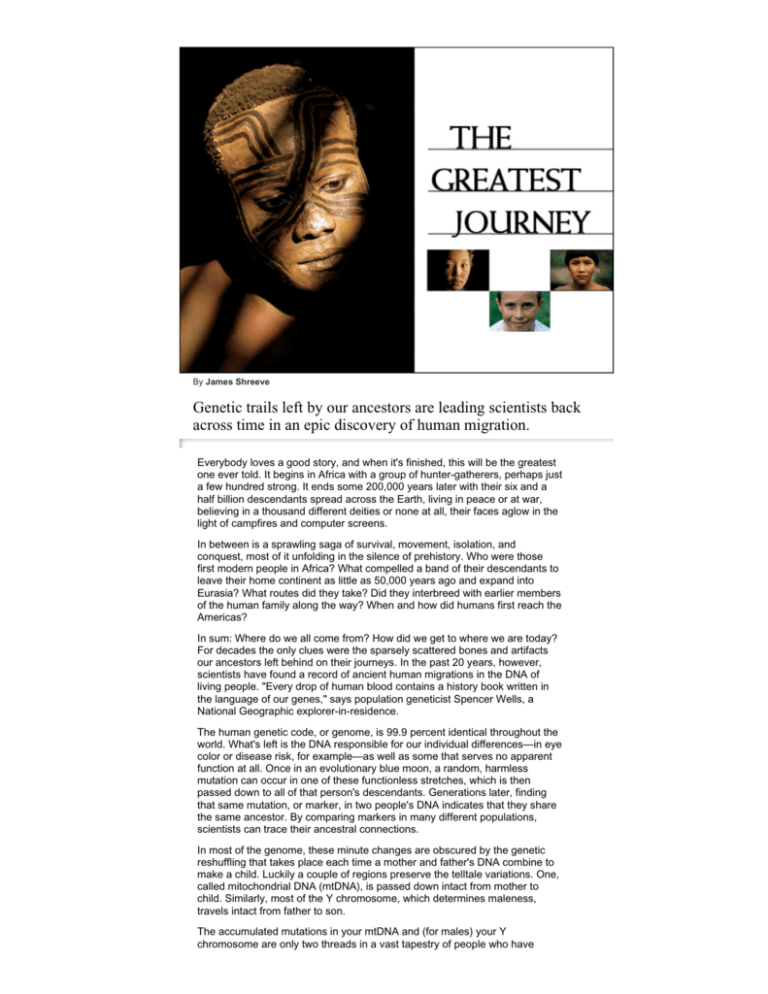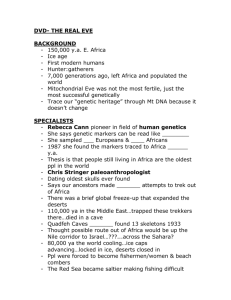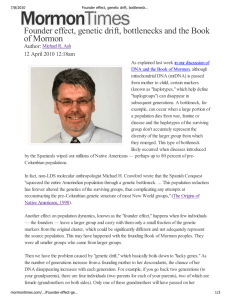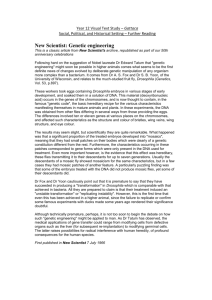
By James Shreeve
Genetic trails left by our ancestors are leading scientists back
across time in an epic discovery of human migration.
Everybody loves a good story, and when it's finished, this will be the greatest
one ever told. It begins in Africa with a group of hunter-gatherers, perhaps just
a few hundred strong. It ends some 200,000 years later with their six and a
half billion descendants spread across the Earth, living in peace or at war,
believing in a thousand different deities or none at all, their faces aglow in the
light of campfires and computer screens.
In between is a sprawling saga of survival, movement, isolation, and
conquest, most of it unfolding in the silence of prehistory. Who were those
first modern people in Africa? What compelled a band of their descendants to
leave their home continent as little as 50,000 years ago and expand into
Eurasia? What routes did they take? Did they interbreed with earlier members
of the human family along the way? When and how did humans first reach the
Americas?
In sum: Where do we all come from? How did we get to where we are today?
For decades the only clues were the sparsely scattered bones and artifacts
our ancestors left behind on their journeys. In the past 20 years, however,
scientists have found a record of ancient human migrations in the DNA of
living people. "Every drop of human blood contains a history book written in
the language of our genes," says population geneticist Spencer Wells, a
National Geographic explorer-in-residence.
The human genetic code, or genome, is 99.9 percent identical throughout the
world. What's left is the DNA responsible for our individual differences—in eye
color or disease risk, for example—as well as some that serves no apparent
function at all. Once in an evolutionary blue moon, a random, harmless
mutation can occur in one of these functionless stretches, which is then
passed down to all of that person's descendants. Generations later, finding
that same mutation, or marker, in two people's DNA indicates that they share
the same ancestor. By comparing markers in many different populations,
scientists can trace their ancestral connections.
In most of the genome, these minute changes are obscured by the genetic
reshuffling that takes place each time a mother and father's DNA combine to
make a child. Luckily a couple of regions preserve the telltale variations. One,
called mitochondrial DNA (mtDNA), is passed down intact from mother to
child. Similarly, most of the Y chromosome, which determines maleness,
travels intact from father to son.
The accumulated mutations in your mtDNA and (for males) your Y
chromosome are only two threads in a vast tapestry of people who have
contributed to your genome. But by comparing the mtDNA and Y
chromosomes of people from various populations, geneticists can get a rough
idea of where and when those groups parted ways in the great migrations
around the planet.
In the mid-1980s the late Allan Wilson and colleagues at the University of
California, Berkeley, used mtDNA to pinpoint humanity's ancestral home.
They compared mtDNA from women around the world and found that women
of African descent showed twice as much diversity as their sisters. Since the
telltale mutations seem to occur at a steady rate, modern humans must have
lived in Africa twice as long as anywhere else. Scientists now calculate that all
living humans are related to a single woman who lived roughly 150,000 years
ago in Africa, a "mitochondrial Eve." She was not the only woman alive at the
time, but if geneticists are right, all of humanity is linked to Eve through an
unbroken chain of mothers.
Mitochondrial Eve was soon joined by "Y chromosome Adam," an analogous
father of us all, also from Africa. Increasingly refined DNA studies have
confirmed this opening chapter of our story over and over: All the variously
shaped and shaded people of Earth trace their ancestry to African
hunter-gatherers.
Looking more closely at DNA markers in Africa, scientists may have found
traces of those founders. Ancestral DNA markers turn up most often among
the San people of southern Africa and the Biaka Pygmies of central Africa, as
well as in some East African tribes. The San and two of the East African tribes
also speak languages that feature a repertoire of unique sounds, including
clicks. Perhaps these far-flung people pay witness to an expansion of our
earliest ancestors within Africa, like the fading ripples from a pebble dropped
in a pond.
What seems virtually certain now is that at a remarkably recent
date—probably between 50,000 and 70,000 years ago—one small wavelet
from Africa lapped up onto the shores of western Asia. All non-Africans share
markers carried by those first emigrants, who may have numbered just a
thousand people.
Some archaeologists think the migration out of Africa marked a revolution in
behavior that also included more sophisticated tools, wider social networks,
and the first art and body ornaments. Perhaps some kind of neurological
mutation had led to spoken language and made our ancestors fully modern,
setting a small band of them on course to colonize the world. But other
scientists see finely wrought tools and other traces of modern behavior
scattered around Africa long before those first steps outside the continent.
"It's not a 'revolution' if it took 200,000 years," says Alison Brooks of George
Washington University.
Whatever tools and cognitive skills the emigrants packed with them, two paths
lay open into Asia. One led up the Nile Valley, across the Sinai Peninsula,
and north into the Levant. But another also beckoned. Seventy thousand
years ago the Earth was entering the last ice age, and sea levels were sinking
as water was locked up in glaciers. At its narrowest, the mouth of the Red
Sea between the Horn of Africa and Arabia would have been only a few miles
wide. Using primitive watercraft, modern humans could have crossed over
while barely getting their feet wet.
Once in Asia, genetic evidence suggests, the population split. One group
stalled temporarily in the Middle East, while the other followed the coast
around the Arabian Peninsula, India, and beyond. Each generation may have
pushed just a couple of miles farther.
"The movement was probably imperceptible," says Spencer Wells, who heads
the National Geographic Society's Genographic Project, a global effort to
refine the picture of early migrations (see page 70). "It was less of a journey
and probably more like walking a little farther down the beach to get away
from the crowd."
Over the millennia, a few steps a year and a few hops by boat added up. The
wanderers had reached southeastern Australia by 45,000 years ago, when a
man was buried at a site called Lake
Mungo. Artifact-bearing soil layers beneath the burial could be as old as
50,000 years—the earliest evidence of modern humans far from Africa.
No physical trace of these people has been found along the 8,000 miles from
Africa to Australia—all may have vanished as the sea rose after the Ice Age.
But a genetic trace endures. A few indigenous groups on the Andaman
Islands near Myanmar, in Malaysia, and in Papua New Guinea—as well as
almost all Australian Aborigines—carry signs of an ancient mitochondrial
lineage, a trail of genetic bread crumbs dropped by the early migrants.
People in the rest of Asia and Europe share different but equally ancient
mtDNA and Y-chromosome lineages, marking them as descendants of the
other, stalled branch of the African exodus. At first, rough terrain and the Ice
Age climate blocked further progress. Europe, moreover, was a stronghold of
the Neandertals, descendants of a much earlier migration of pre-modern
humans out of Africa.
Finally, perhaps 40,000 years ago, modern humans advanced into the
Neandertals' territory. Overlapping layers of Neandertal and early modern
human artifacts at a cave in France suggest that the two kinds of humans
could have met.
How these two peoples—the destined parvenu and the doomed caretaker of
a continent—would have interacted is a potent mystery. Did they eye each
other with wonder or in fear? Did they fight, socialize, or dismiss each other
as alien beings?
All we know is that as modern humans and distinctly more sophisticated
toolmaking spread into Europe, the once ubiquitous Neandertals were
squeezed into ever shrinking pockets of habitation that eventually petered out
completely. On current evidence, the two groups interbred rarely, if at all.
Neither mtDNA from Neandertal fossils nor modern human DNA bears any
trace of an ancient mingling of the bloodlines.
About the same time as modern humans pushed into Europe, some of the
same group that had paused in the Middle East spread east into Central Asia.
Following herds of game, skirting mountain ranges and deserts, they reached
southern Siberia as early as 40,000 years ago. As populations diverged and
became isolated, their genetic lineages likewise branched and rebranched.
But the isolation was rarely if ever complete. "People have always met other
people, found them attractive, and had children," says molecular
anthropologist Theodore Schurr of the University of Pennsylvania.
Schurr's specialty is the peopling of the Americas—one of the last and most
contentious chapters in the human story. The subject seems to attract
fantastic theories (Native Americans are the descendants of the ancient
Israelites or the lost civilization of Atlantis) as well as ones tinged with a
political agenda. The "Caucasoid" features of a 9,500-year-old skull from
Washington State called Kennewick Man, for instance, have been hailed as
proof that the first Americans came from northern Europe.
In fact most scientists agree that today's Native Americans descend from
ancient Asians who crossed from Siberia to Alaska in the last ice age, when
low sea level would have exposed a land bridge between the continents. But
there's plenty of debate about when they came and where they originated in
Asia.
For decades the first Americans were thought to have arrived around 13,000
years ago as the Ice Age eased, opening a path through the ice covering
Canada. But a few archaeologists claimed to have evidence for an earlier
arrival, and two early sites withstood repeated criticism: the Meadow-croft
Shelter in Pennsylvania, now believed to be about 16,000 years old, and
Monte Verde in southern Chile, more than 14,000 years old.
The DNA of living Native Americans can help settle some of the disputes.
Most carry markers that link them unequivocally to Asia. The same markers
cluster in people who today inhabit the Altay region of southern Siberia,
suggesting it was the starting point for a journey across the land bridge. So
far, the genetic evidence doesn't show whether North and South America
were populated in a single, early migration or two or three distinct waves, and
it suggests only a rough range of dates, between 20,000 and 15,000 years
ago. Even the youngest of those dates is older than the opening of an inland
route through the Canadian ice. So how did the first Americans get here?
They probably traveled along the coast: perhaps a few hundred people
hopping from one pocket of land and sustenance to the next, between a frigid
ocean and a looming wall of ice. "A coastal route would have been the easiest
way in," says Wells. "But it still would have been a hell of a trip." Beyond the
glaciers lay immense herds of bison, mammoths, and other animals on a
continent innocent of other intelligent predators. Pushed by population growth
or pulled by the lure of game, people spread to the tip of South America in as
little as a thousand years.
The genes of today's Native Americans are helping to bring their ancestors'
saga to life. But much of the story can only be imagined, says Jody Hey, a
population geneticist at Rutgers University. "You can't tell it with the richness
of what must have happened." With the settling of the Americas, modern
humans had conquered most of the planet. When European explorers set sail
700 years ago, the lands they "discovered" were already full of people. The
encounters were often wary or violent, but they were the reunions of a
close-knit family.
Perhaps the most wonderful of the stories hidden in our genes is that, when
unraveled, the tangled knot of our global genetic diversity today leads us all
back to a recent yesterday, together in Africa.
W hat G enes and F ossils T ell Us
S cientists have long held that modern humans originated in Africa because that's where
they've found the oldest bones. G eneticists have come to the same conclusion by looking at
Africa's vast genetic diversity, which could only have arisen as DNA mutated over millennia.
T here's less consensus about the routes our ancestors took in their journey out of Africa
and around the planet. E arly migrations stalled but left behind evidence such as a human
skull from 92,000 years ago at Qafzeh, Israel. T hose people may have taken a northern
route through the Nile Valley into the Middle E ast. B ut other emigrants who left Africa tens
of thousands of years later could also have taken a different route: across the southern end
of the R ed S ea. S cientists say these more recent wanderers gave rise to the 5.5 billion
humans living outside Africa today. "I think the broad human prehistoric framework is in
place," says geneticist P eter F orster of the McDonald Institute for Archaeological R esearch
in C ambridge, E ngland, "and we are now fitting in the details."
1. A fric an C radle
Most paleoanthropologists and geneticists agree that modern humans arose some 200,000
years ago in Africa. T he earliest modern human fossils were found in Omo K ibish, E thiopia.
S ites in Israel hold the earliest evidence of modern humans outside Africa, but that group
went no farther, dying out about 90,000 years ago.
2. Out of A fric a
G enetic data show that a small group of modern humans left Africa for good 70,000 to
50,000 years ago and eventually replaced all earlier types of humans, such as Neandertals.
All non-Africans are the descendants of these travelers, who may have migrated around the
top of the R ed S ea or across its narrow southern opening.
3. T he F irs t A us tralians
Discoveries at two ancient sitesÑ artifacts from Malakunanja and fossils from Lake
MungoÑ indicated that modern humans followed a coastal route along southern Asia and
reached Australia nearly 50,000 years ago. Their descendants, Australian Aborigines,
remained genetically isolated on that island continent until recently.
4. Early Europeans
P aleoanthropologists long thought that the peopling of E urope followed a route from North
Africa through the Levant. B ut genetic data show that the DNA of today's western
E urasians resembles that of people in India. It's possible that an inland migration from Asia
seeded E urope between 40,000 and 30,000 years ago.
5. P opulating A s ia
Around 40,000 years ago, humans pushed into C entral Asia and arrived on the grassy
steppes north of the Himalaya. At the same time, they traveled through S outheast Asia and
C hina, eventually reaching J apan and S iberia. G enetic clues indicate that humans in northern
Asia eventually migrated to the Americas.
6. Into the New W orld
E xactly when the first people arrived in the Americas is still hotly debated. G enetic evidence
suggests it was between 20,000 and 15,000 years ago, when sea levels were low and land
connected S iberia to Alaska. Ice sheets would have covered the interior of North America,
forcing the new arrivals to travel down the west coast.
Kennewick
6
9,500 years ago
20,000-15,000
years ago
Spirit Cave
9,500-9,400
years ago
Yana River
NORTH
AMERICA
30,000 years ago
Clovis
13,500
years ago
40,000
years ago
Meadowcroft
5
19,000-12,000
years ago
Zhoukoudian
(Shandingdong)
11,000 years ago
EUROPE
4
Minatogawa
ASIA
Pestera cu Oase
35,000 years ago
18,000 years ago
40,000-30,000
years ago
Qafzeh
100,000
years ago
Nile
River
Red
Sea
2
70,000-50,000
years ago
Omo Kibish
AFRICA
1
Oldest modern human
195,000 years ago
200,000
years ago
Andaman
Islands
Niah Cave
40,000 years ago
EQUATOR
SOUTH
AMERICA
Malakunanja
50,000 years ago
Klasies River Mouth
120,000 years ago
3
AUSTRALIA
15,000-12,000
years ago
Monte Verde
50,000
years ago
Human Migration
14,800 years ago
Fossil or
artifact site
40,000
years ago
Migration date
Generalized route
SOURCES: SUSAN ANTON, NEW YORK UNIVERSITY; ALISON BROOKS, GEORGE WASHINGTON UNIVERSITY; PETER
FORSTER, UNIVERSITY OF CAMBRIDGE; JAMES F. O'CONNELL, UNIVERSITY OF UTAH; STEPHEN OPPENHEIMER,
OXFORD UNIVERSITY; SPENCER WELLS, NATIONAL GEOGRAPHIC SOCIETY; OFER BAR-YOSEF, HARVARD UNIVERSITY
NGM MAPS
© 2006 National Geographic Society. All rights reserved.
Lake Mungo
45,000 years ago










